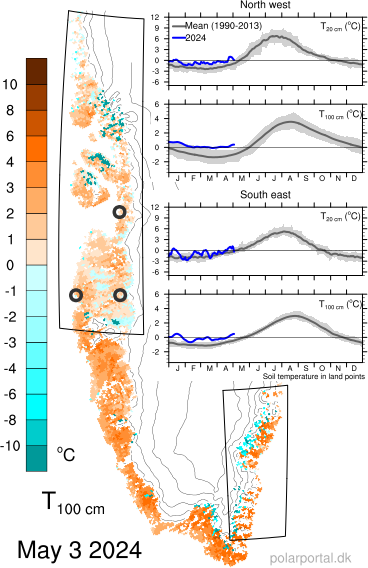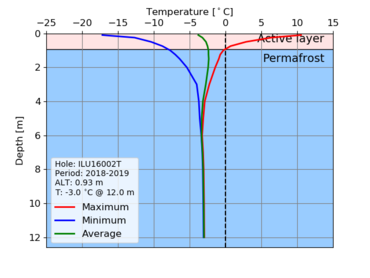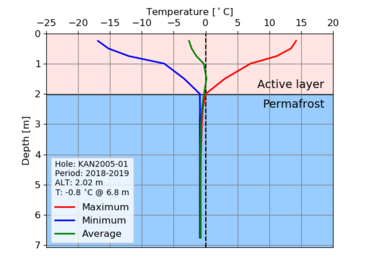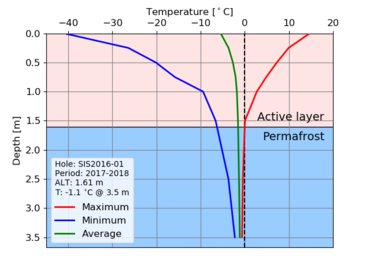
The figure to the left shows the ground temperature measured at different depths below the ground surface by the Greenland town Ilulissat, a so-called temperature profile. The figure is active, and by using the slider below, you can flip through temperature profiles measured on different dates. The black curve represent the temperature profile on the indicated date, while the lighter gray curves show the temperature profiles on the previous dates for comparison. By looking at the temporal variation in ground temperature, you can see how the upper part of the ground thaws in the summer and freezes in winter. This layer, which thaws and freezes with the seasons, is called the Active Layer.
The thermal variation in the ground is primarily driven by the variation in air temperature, but is also affected by precipitation (especially snow), the ground surface properties (e.g. vegetation, color, etc.) and the insolation, as well as the ground thermal properties and water/ice-content.
In the other figure, a so-called trumpet curve is shown. Here the red curves represents the maximum temperature measured at each depth in the course of one year. The blue curve similarly shows the coldest temperature measured at each sensor depth and the green curve the average temperature over one year. From the trumpet-curve, the active layer thickness (the maximum thaw depth) and the permafrost temperature can be found. The part of the ground considered permafrost has a light blue background color in the figure.
The figure to the left shows the ground temperature measured at different depths below the ground surface by the Greenland town Kangerlussuaq, a so-called temperature profile. The figure is active, and by using the slider below, you can flip through temperature profiles measured on different dates. The black curve represent the temperature profile on the indicated date, while the lighter gray curves show the temperature profiles on the previous dates for comparison. By looking at the temporal variation in ground temperature, you can see how the upper part of the ground thaws in the summer and freezes in winter. This layer, which thaws and freezes with the seasons, is called the Active Layer.
The thermal variation in the ground is primarily driven by the variation in air temperature, but is also affected by precipitation (especially snow), the ground surface properties (e.g. vegetation, color, etc.) and the insolation, as well as the ground thermal properties and water/ice-content.
In the other figure, a so-called trumpet curve is shown. Here the red curves represents the maximum temperature measured at each depth in the course of one year. The blue curve similarly shows the coldest temperature measured at each sensor depth and the green curve the average temperature over one year. From the trumpet-curve, the active layer thickness (the maximum thaw depth) and the permafrost temperature can be found. The part of the ground considered permafrost has a light blue background color in the figure.
The figure to the left shows the ground temperature measured at different depths below the ground surface by the Greenland town Sisimiut, a so-called temperature profile. The figure is active, and by using the slider below, you can flip through temperature profiles measured on different dates. The black curve represent the temperature profile on the indicated date, while the lighter gray curves show the temperature profiles on the previous dates for comparison. By looking at the temporal variation in ground temperature, you can see how the upper part of the ground thaws in the summer and freezes in winter. This layer, which thaws and freezes with the seasons, is called the Active Layer.
The thermal variation in the ground is primarily driven by the variation in air temperature, but is also affected by precipitation (especially snow), the ground surface properties (e.g. vegetation, color, etc.) and the insolation, as well as the ground thermal properties and water/ice-content.
In the other figure, a so-called trumpet curve is shown. Here the red curves represents the maximum temperature measured at each depth in the course of one year. The blue curve similarly shows the coldest temperature measured at each sensor depth and the green curve the average temperature over one year. From the trumpet-curve, the active layer thickness (the maximum thaw depth) and the permafrost temperature can be found. The part of the ground considered permafrost has a light blue background color in the figure.











